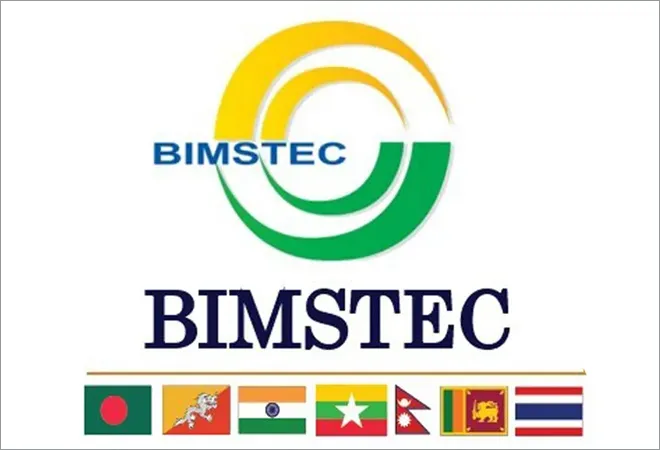
The upcoming Bay of Bengal Initiative for Multisectoral Technical and Economic Cooperation (BIMSTEC) summit on 30 March is going to be hosted by Sri Lanka and is the first in-person meeting to be held since the
last summit in Kathmandu in 2018. The grouping will host its fifth summit in the last 25 years since its formation. The
summit should see the approval of the BIMSTEC Charter, BIMSTEC Master Plan for Transport Connectivity, and BIMSTEC Convention on Mutual Legal Assistance in Criminal Matters. The BIMSTEC Coastal Shipping Agreement and the Motor Vehicles Agreement still await finalisation. This sub-regional grouping, formed in 1997, has had minimal interaction and modest achievements until now.
The idea behind the formation of this grouping was to remedy the lack of connectedness between South Asia and Southeast Asia. The
BIMSTEC region has a population of roughly 22 percent of the global population with a combined GDP of over US$2.7 trillion. The ambit of cooperation within the BIMSTEC includes 14 areas—Agriculture, Tourism, Transport and Communication, Counter-terrorism and Transnational Crime, Environment and Disaster Management, Trade and Investment, Cultural Cooperation, Energy, Poverty Alleviation, Technology, Public Health, Fisheries, People-to-People Contact, and Climate Change. According to the
MEA BIMSTEC Brief, India is the leader in Transport and Communication, Tourism, Environment and Disaster Management, and Counter Terrorism and Transnational Crime.
The 2016 BRICS-BIMSTEC Outreach Summit held after the cancellation of the SAARC Summit was indicative of New Delhi’s intent to stimulate the grouping and fill the vacuum left behind by the obsoletion of SAARC.
For India, BIMSTEC allows the confluence of its Act East and the Neighbourhood Policies. This, while in itself being favourable, also allows it to coincide with its strategic view of the Indo-Pacific theatre. India’s renewed interest in the BIMSTEC has led to its rejuvenation. The 2016 BRICS-BIMSTEC Outreach Summit held after the cancellation of the SAARC Summit was indicative of New Delhi’s intent to stimulate the grouping and fill the vacuum left behind by the obsoletion of SAARC. For the 2019 oath ceremony by the Prime Minister upon his re-election, India chose to invite the BIMSTEC leaders. Furthermore, India indicated its interest in solidifying its ties with the BIMSTEC when the then newly appointed External Affairs Minister, Dr S. Jaishankar
talked about the “energy, mindset and possibility” amongst the BIMSTEC nations. Due to the failure of SAARC, given the Indo-Pak hostilities, India has turned to the BIMSTEC nations for expanding its reach and presence in the Indo-Pacific region. India’s foreign policy is criticised to be mingled in the power rivalry in the world. This had prevented India from having a global footprint and in realising its ambition of becoming a global leader. During the Cold War, India’s foreign policy was dealing with the rivalry between the two power blocs.
The end of the Cold War forced India to recalibrate its foreign policy and the US assumed the centre position in it. Today, India’s foreign policy is primarily concerned with the US and China power nexus. However, it’s also the China concern which has forced India to shift its focus primarily from the US to start counting upon smaller and middle power nations. This has made it turn to the other Indo-Pacific nations, particularly in Southeast Asia. This is how BIMSTEC became important to serve India’s security concerns in the Indo-Pacific. It has provided India with the opportune moment to build its base in the Southeast outside of its engagements with the ASEAN. For the grouping, India is the informal leader since much depends on the country’s willingness to energise it. This is also India’s opportunity to reconnect with its neighbours and revamp its image of being the ‘big brother’ in the region. Much of India’s image in its neighbourhood and extended neighbourhood has suffered from instrumental creditability issues and hegemonic actions. The capacity of BIMSTEC also gives India the possibility to strengthen relations with the ASEAN and the vice versa is also equally true.
The Bangladesh–Myanmar row over the Rohingya crisis, India–Nepal border issue, and India–Sri Lanka rift over fishing and detention of fishermen have fed to the latency in the organisation.
While BIMSTEC serves myriad opportunities and situations for remarkable growth, bilateral relations amongst member countries have also impeded the functioning of the organisation. The Bangladesh–Myanmar row over the Rohingya crisis, India–Nepal border issue, and India–Sri Lanka
rift over fishing and detention of fishermen have fed to the latency in the organisation. The enhancing bilateral relations between the nations have also diluted their interest in contributing significantly to the organisation. Over the years, nations have directed their energy towards ensuring the success of bilateral or multilateral initiatives (India–Myanmar–Thailand Highway Project, the Kaladan River project, and the Bhutan Bangladesh India Nepal initiative), and this has denied the grouping of concrete participation from the member nations. The domestic situation of these nations can also prove to be significant threats. The BIMSTEC region is prone to weapon and drug trafficking which further aggravate the volatile situation in India’s Northeast.
The current Sri Lankan economic crisis, the
insurgent groups in Myanmar, and the
issue of trade unions in Myanmar and Thailand have long-term impact on the considerations of the grouping and could restrain the actualisation of its initiatives. For India, the militant activities in the Northeast pose a threat to the success of its initiatives. The member countries’ participation is also bound by their relations with China. Only Bhutan and India aren’t part of any Belt and Road Initiative (BRI) infrastructure projects. With the Russia–Ukraine crisis, China is bound to turn its attention to its BRI project in Asia. This puts India in a position to deal with renewed and solid attention from China to its neighbouring countries.
Indian business groups have shown evidential interest in dealing in the region with 94 percent of them voting in favour of it in the FICCI Survey. Furthermore, the grouping also needs to focus on extending its activities to the sea and formulate policies on the development of ‘Blue Economy’.
For BIMSTEC to become more relevant, it has to engage extra-regional like-minded partners, willing to invest in the region. Even engaging countries like Malaysia, Singapore, Philippines, and Cambodia can lead to an expansion of its activities. Simultaneously, taking BIMSTEC to other groupings outside of the region is also crucial. One such favourable partnership could be with the Quad. This also gives them the opportunity to balance against both India and China as well as the US. While the focus of BIMSTEC activities have usually been on
environment and disaster management, the finalisation of initiatives in other areas is especially crucial. One such sector is the financial and economic exchange, for which the finalisation of the Free Trade Agreement is necessary. Indian business groups have
shown evidential interest in dealing in the region with
94 percent of them voting in favour of it in the FICCI Survey. Furthermore, the grouping also needs to focus on extending its activities to the sea and formulate policies on the development of ‘Blue Economy’. Given the region’s relation to the Indo-Pacific, increasing dialogue on maritime security and establishing codes for future engagement in the same can be helpful to counter China’s strategic voyages in the seas.
In terms of its functioning, a key challenge is securing requisite financing for undertaking the above-mentioned measures. The organisation should focus on reforming its internal structuring to better enable it to both take and implement decisions. In the absence of this, the BIMSTEC will continue to be inundated by latency and inactivity.
The upcoming summit is expected to provide further momentum to the grouping, especially after the dormancy due to the pandemic. However, it will also test the strength of the grouping given the shift in the balance of power in Asia, the world’s response to Russian aggression in Ukraine, and their evolving national interests in the light of a rapidly developing world.
Muskaan Goenka is a Research Intern with ORF Kolkata.
The views expressed above belong to the author(s). ORF research and analyses now available on Telegram! Click here to access our curated content — blogs, longforms and interviews.



 The upcoming Bay of Bengal Initiative for Multisectoral Technical and Economic Cooperation (BIMSTEC) summit on 30 March is going to be hosted by Sri Lanka and is the first in-person meeting to be held since the
The upcoming Bay of Bengal Initiative for Multisectoral Technical and Economic Cooperation (BIMSTEC) summit on 30 March is going to be hosted by Sri Lanka and is the first in-person meeting to be held since the  PREV
PREV


